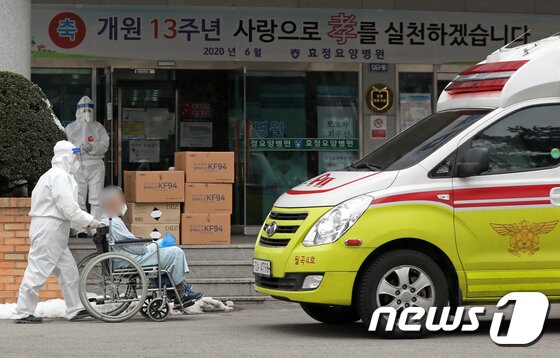 |
| On the afternoon of the 3rd, officials from the quarantine authorities are transporting corona19 confirmed patients at Hyojeong Nursing Hospital in Gwangsan-gu, Gwangju. As of 2 p.m. on the day, 9 workers, including nurses and caregivers in the nursing hospital, and 53 people, including hospitalized patients, were diagnosed with Corona 19 within two days. 2021.1.3/News1 © News1 Reporter Hwang Hee-gyu |
In December of last year, a new coronavirus infection (Corona 19) confirmed, and 996 confirmed cases and 99 deaths occurred in 14 nursing hospitals where the same group was quarantined (cohort quarantine).
Most nursing hospital beds are suffering from overcrowding with 6 to 7 beds, and it is interpreted that the inpatients have underlying diseases in the beds.
The Central Disaster and Safety Countermeasure Headquarters announced on the 3rd that it had been reported and discussed the’nursing hospital emergency medical response plan’ from the Central Accident Recovery Headquarters (hereinafter referred to as the heavy water version) of the Ministry of Health and Welfare.
In December last year, the quarantine authorities expanded the diagnostic tests for workers as confirmed cases occurred one after another in nursing hospitals.
First of all, national nursing hospital workers shorten the gene amplification (PCR) diagnostic test cycle to one week, and workers who have been to high-risk groups and high-risk areas perform rapid antigen tests to confirm negative before putting them into work. Until now, workers in the metropolitan area and non-metropolitan areas have been inspected every 2 weeks.
Nursing hospitals and local government officials are designated on a one-to-one basis to check compliance with the quarantine rules by phone every day, and visit inspections if necessary. In the event of a confirmed case, an additional provincial quarantine officer will be appointed and closely managed.
Three emergency field response teams are formed, including the heavy water headquarters, the central quarantine countermeasure headquarters of the Korea Centers for Disease Control and Prevention, the National Medical Center, and experts, and dispatched immediately after infection occurs. These three teams support initial response such as identification of exposed persons and contacts and assessment of the situation, preparation of isolation and power supply plans, and human and physical support.
When quarantining patients in nursing hospitals, separate patient types such as confirmed, non-contact, and close contact, and separate spaces for the same group to isolate. This is a measure to prevent cross-infection. It is also planning to support personnel who support caring tasks such as caring for people who are vulnerable to cross-infection and meal distribution.
If the number of confirmed cases is large, non-contact persons are promptly transferred to other nursing hospitals, and medical personnel are secured and supplies are provided for the remaining patients.
If the number of confirmed cases is small, the confirmed person is transferred to a dedicated nursing hospital or a treatment bed dedicated to severe severity, and non-confirmed persons are classified into non-contact and close contact, and are quarantined and observed for 14 days.
When all patients in need of 24-hour care are provided, caregivers are secured and supported. General nursing hospitals and dedicated nursing hospitals are designated for each province, and hospitals receiving all patients are supported through health insurance or compensation for losses.
“We will build a joint response system so that local government officials and nursing hospitals can communicate immediately,” the script explained, “We plan to support those who have been released from quarantine so that medical services can be continuously linked.”
